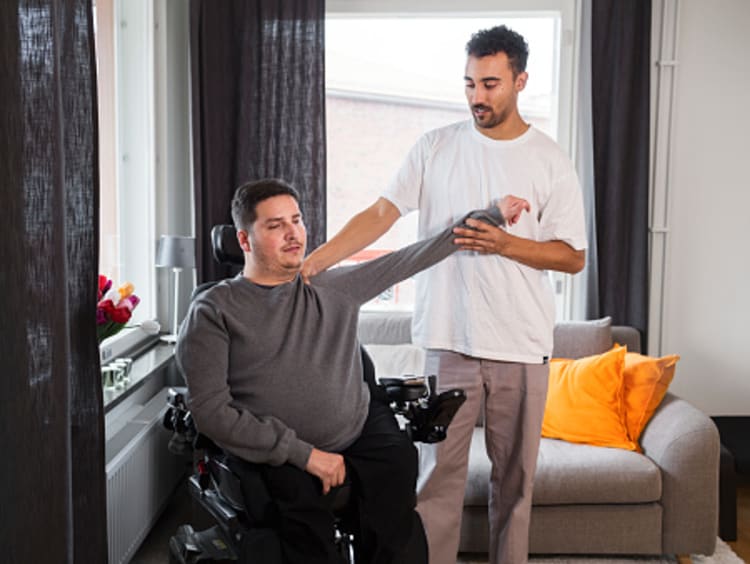How To Become a Physical Therapist Assistant

Are you interested in a growing career in the healthcare industry? Plus, assistants can enjoy the personal satisfaction that comes from knowing their work makes a positive difference in people’s lives.
Taking a Closer Look at This Career
A physical therapist assistant works under the supervision of a physical therapist. Although the physical therapist (PT) is responsible for managing the patient’s care and making important decisions, the PTA is directly involved in delivering care. PTAs help patients reduce their pain and improve their level of functioning. Although the specific tasks can vary from one office to the next but may include:
- Carefully observing patients and reporting all findings to the physical therapist.
- Providing instructions to the patient and their family members.
- Assisting patients in performing corrective stretches and exercises, making sure their form is correct.
- Helping patients use assistive devices, such as walkers.
- Performing a variety of treatment modalities for patients, such as massage and passive stretching.
Effective assistants are excellent communicators. It’s essential to be able to clearly communicate treatment plans and exercise steps to patients. Similarly, PTAs must clearly communicate their observations and rehabilitative treatment recommendations to the PT. It should also be noted that some patients require extrinsic motivation to complete the treatment plan. An effective PTA will help patients stay on track with their rehab by encouraging them to do their recommended exercise at home between appointments.
Acquiring a Physical Therapy Degree
If you’ve decided that becoming a PTA is the right choice for you, then your first step is to earn a physical therapy degree. You will need to complete an education program that has been accredited by the Commission on Accreditation in Physical Therapy Education (CAPTE). CAPTE is the only PT and PTA accreditation agency that has been officially recognized by the U.S. Department of Education and the Council for Higher Education Accreditation (CHEA).1
Enrolling in an accredited PTA program ensures that you will acquire all of the necessary knowledge and skills to successfully obtain licensure or certification and become a practicing physical therapy assistant. During your program, you can expect to study topics such as the following:
- Human anatomy and physiology
- Therapeutic exercise and soft tissue mobilization
- Sports injury management and prevention
- Orthotics and prosthetics
- Clinical pharmacology
Passing the State Licensure and Certification Requirements
After graduating from an accredited physical therapy assistant program, individuals can then work on completing the other mandatory stepping stones toward becoming a practicing PTA. Each state has its own licensure or certification requirements.
Most states require aspiring PTAs to pass the National Physical Therapy Exam, which is administered by the Federation of State Boards of Physical Therapy. Some states may also require applicants to successfully complete an exam designed to test their knowledge of the state’s applicable regulations for the field. In addition, some states require PTAs to pass a criminal background check and be at least 18 years of age. Once a physical therapy assistant is properly licensed or certified, it may be necessary to periodically take continuing education courses in order to keep their license active.
Landing a Job as a Physical Therapy Assistant
A qualified physical therapy assistant may find work in any setting that hires physical therapists. Many of these professionals work in hospitals, rehabilitative medicine clinics and elder care facilities. Others may work for in-home health aide and hospice agencies. Collegiate and professional sports organizations are other examples of potential employers.
Although physical therapy assistants are in high demand, it may still take patience and persistence to land that first job. Professional networking can be particularly helpful for PTAs. For example, you might look for volunteering opportunities that are aligned with your professional interests. If you’re interested in working with athletes, consider volunteering with Little League, for example. It’s also helpful to acquire additional skills and certifications that can make you a competitive candidate. For example, you can get certified in cardiopulmonary resuscitation (CPR) through the American Red Cross.
Grand Canyon University is pleased to play a role in educating the next generation of medical science professionals. Explore our healthcare degree programs offered by the College of Natural Sciences, including the Bachelor of Science in Exercise Science with an Emphasis in Pre-Physical Therapy. Take the first step toward a rewarding career in healthcare by clicking on Request Info at the top of your screen.
1CAPTE. n.d. Welcome to the Commission on Accreditation in Physical Therapy Education. capteonline.org. Retrieved December, 2020.
The views and opinions expressed in this article are those of the author’s and do not necessarily reflect the official policy or position of Grand Canyon University. Any sources cited were accurate as of the publish date.


